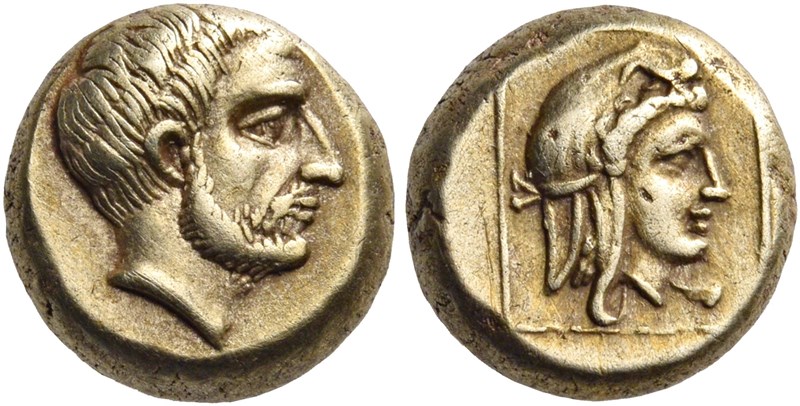Lot 146

LESBOS. Mytilene. Circa 333/332 BC. Hekte (Electrum, 9 mm, 2.56 g, 12 h). Bare-headed and bearded male head to right, very probably the oligarch and tyrant Diogenes of Mytilene or, possibly, the Athenian general Chares. Rev. Youthful, beardless male head to right, wearing a Phrygian cap bound with a taenia or diadem with ties behind (or a satrapal headdress); all within a linear square. Bodenstedt 102.1 = Jameson 2251 = Weber 5637 (same dies). Extremely rare and of great interest. With one of the few portraits of a living person to appear on a Greek coin prior to those of the successors of Alexander. A few very minor marks on the reverse, otherwise, about extremely fine.
The plain male head on the obverse of this coin simply has to be that of a living individual rather than a mythological figure. His lack of any form of headdress indicates that he was not a royal figure; he was certainly not a Persian. Historical circumstances provide us with a clue to why this head is here. In 334 Mytilene, along with the other cities on the west coast of Asia Minor, had fallen under the sway of Alexander, but about a year later Darius's admiral, the Rhodian Memnon, retook most of the lost Aegean cities, Mytilene itself being captured after a siege in 333. Memnon died during the siege and command passed to the Persian nobles Pharnabazos (III) and his elderly companion Autophradates, Satrap of Lydia and Ionia. They, in turn, installed a certain Diogenes, an exiled Mytilenian oligarch, as ruler of the city. At some later in 332 the Athenian general Chares, who was long associated with the city's anti-Macedonian faction, took over military command on the island. Since this coin almost certainly had to be struck c. 332, the portrait equally almost certainly has to be of one of those two men. Either of them would be good candidates for the man depicted on this coin, but the reverse may make Diogenes slightly more likely. This beardless male head is wearing what appears to be a Phrygian cap, but one which, unusually, seems to be bound with a diadem of some sort. If so, that makes it curiously similar to the headdress - termed a satrapal cap - worn by a young man on diobols of Autophradates, struck some two decades earlier (see CNG 96, 2014, 428, and CNG 94, 2013, 506 for full references). This is very probably not a coincidence: thus, if the obverse shows a realistic portrait of Diogenes, the reverse can be seen as showing an idealized and youthful head of Autophradates, who had been instrumental in putting Diogenes back in power.
Rather startlingly, the issue that comes before this one, Bodenstedt 101, shows a head of Zeus on the obverse paired with Nike on the reverse (surely a direct reference to Alexander's liberation of the island), while the following issue, Bodenstedt 103, which was struck after the island was retaken by Alexander's forces, bears another head of Zeus on its obverse paired with a youthful head of Herakles wearing a lion 's skin: a very clear symbol of Macedonian power! And, to top that, this is followed by Bodenstedt 104, with a youthful, beardless head of Zeus-Ammon on the obverse and an eagle on the reverse (another direct reference to Alexander).
Current Status
Online bidding closes: 5 May 2019, 14:30:00 CEST Current Date & Time: 25 Apr 2024, 00:47:06 CEST Remaining Time: Closed Hammer Price:6000 CHFPre-Bidding closes on 5 Mai 2019 at 14:30 CEST. Live bidding starts at 14:00 CET and is EXCLUSIVELY available on biddr. Separate registration is required.
